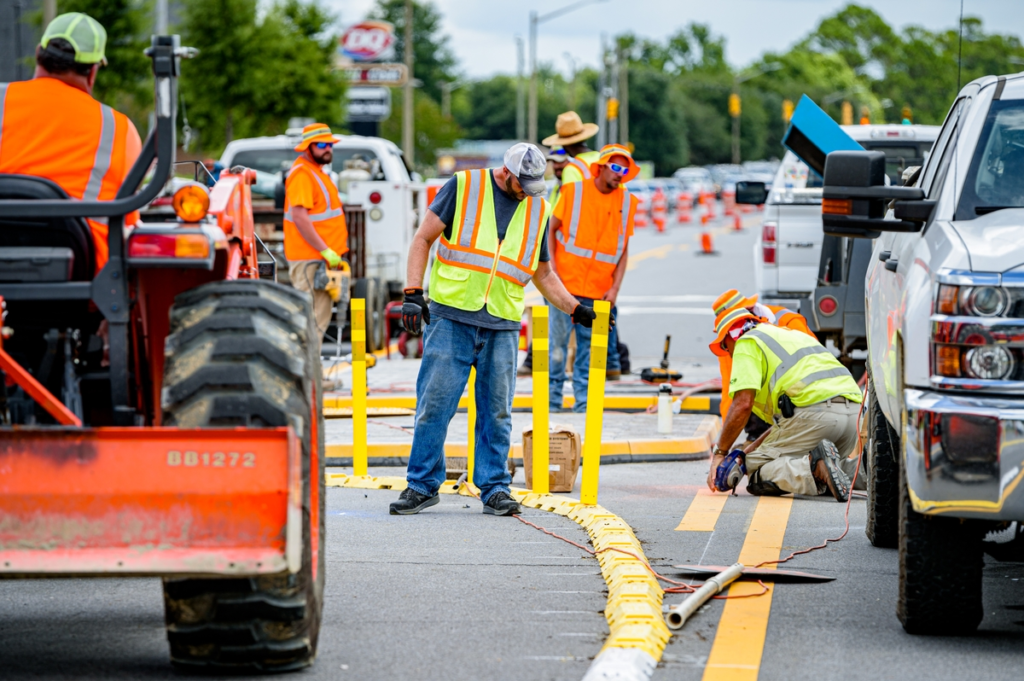When road construction or utility upgrades occur, maintaining safe, reliable access for businesses and residents is essential. Interruptions can hurt local commerce, inconvenience households, and even create safety hazards. At Safety Network Inc., we combine industry best practices (MUTCD, AASHTO) with practical field experience to design traffic control plans that keep driveways, sidewalks, and emergency routes open. Below, we outline a step-by-step guide to ensuring uninterrupted access during all phases of road work.

1. Plan Thoroughly Before Construction Begins
A. Stakeholder Engagement
Engage property owners, business managers, homeowners associations, and emergency services early. Conduct a public meeting or issue a detailed notice explaining:
- Project scope and timeline
- Anticipated impacts on access
- Alternative routes and temporary parking arrangements
Collect feedback on peak business hours, delivery schedules, and special-needs residences to tailor your access plan.
B. Detailed Traffic Control Plan (TCP)
Develop a TCP per the Manual on Uniform Traffic Control Devices (MUTCD) and local specifications:
- Driveway/Sidewalk Closures: Show exact locations; provide phased staging to avoid simultaneous closures.
- Detour Routes: Clearly mark alternate paths for vehicles, pedestrians, and cyclists.
- Signage Layouts: Include advance warning signs and “Local Traffic Only” plates.
- Emergency Access: Identify unimpeded corridors for police, fire, and medical vehicles.
Submit your TCP to the local DOT or Public Works department for review and approval before work begins.
2. Phase Construction to Minimize Disruptions
A. Staged Closures
Break the project into small work zones—no longer than 50–100 ft—allowing adjacent driveways and sidewalks to remain open. Rotate closures so that at least one side of the street is fully accessible at all times.
B. Night or Off-Peak Work
Whenever feasible, schedule the most disruptive tasks during evenings or weekends. This reduces impacts on businesses’ core operating hours and residential commute times.
C. Temporary Pavement & Driveway Ramps
Install smooth, temporary asphalt or steel plate ramps at driveway edges so vehicles and pedestrians transition seamlessly between the work area and open roadway. Ensure ramps meet the grade requirements in AASHTO guidelines to prevent tripping hazards.
3. Provide Clear, Visible Signage and Communication
A. Advance Notice Signage
Place signs 300–500 ft before impacted driveways and sidewalks, using phrases like “Business Access Ahead” or “Sidewalk Closed — Pedestrian Route →.” Use high-contrast, retroreflective sheeting for night visibility.
B. Wayfinding for Pedestrians
When sidewalks are blocked, create ADA-compliant detours using marked crosswalks or temporary ramps on the opposite side of the street. Install guide signs at each decision point.
C. Digital & Print Updates
Maintain a project webpage, email list, and social media updates showing daily status, active closures, and detour maps. Distribute flyers door-to-door a week before major changes and post updates on community bulletin boards.
4. Coordinate with Utility and Delivery Services
A. Utility Companies
Share your TCP with water, gas, electric, and telecom providers to sequence their work alongside yours, avoiding compounded closures. Joint planning reduces overall disruption time.
B. Delivery and Service Providers
Provide local businesses with a contact person and schedule so they can inform their suppliers, garbage collection, and postal services. Arrange temporary loading zones adjacent to active work areas, clearly marked with “Loading Only” signs.
5. Enforce and Monitor Access Throughout
A. On-Site Traffic Control Supervisors
Designate a Competent Person (per OSHA 1926.32(f)) to oversee access points, adjust signage as work shifts advance, and respond to emergencies. They ensure the TCP is followed and can authorize immediate corrections.
B. Daily Inspections
Before each shift, inspect ramps, signage, and detours. Check that no barricades have shifted, and ensure ADA compliance for pedestrian paths. Document findings in a daily log.
C. Rapid Response to Issues
Establish a hotline or dedicated email for residents and business owners to report access problems. Respond within one business day to adjust ramp locations, clear debris, or add temporary signage.
6. Restore and Follow Up After Completion
A. Permanent Restoration
Once construction ends, return driveways, sidewalks, and curbs to their pre-project or improved condition. Perform concrete and asphalt pours, install final striping, and ensure transitions are smooth.
B. Final Walkthrough
Invite stakeholders to a final inspection. Walk the corridor with business owners and residents to confirm full, unobstructed access and address any punch-list items immediately.
C. Post-Project Survey
Send a brief survey to participants asking for feedback on communication, access quality, and overall satisfaction. Use these insights to refine future traffic control plans.
Frequently Asked Questions (FAQs)
Q: What is the minimum notice period for property access changes?
A: Provide at least 72 hours’ notice for any driveway or sidewalk closure. For major disruptions, distribute notices one week in advance.
Q: How do you ensure ADA compliance during sidewalk detours?
A: Detours must maintain a minimum 36-inch clear width, with ramps not steeper than a 1:12 slope. Install handrails where slopes exceed 5%.
Q: Who do we call if an emergency vehicle is blocked?
A: Contact the on-site Traffic Control Supervisor immediately. They can clear the path or reroute the road crew to facilitate emergency access.
Q: Can businesses still receive deliveries during closures?
A: Yes. We coordinate with suppliers and provide temporary loading zones adjacent to the work zone, marked with clear signage.
Q: What happens if weather delays the project?
A: We update signage and digital channels in real time. Temporary restoration (e.g., steel plates or cold-mix asphalt) ensures safe access until permanent work resumes.
Conclusion
Maintaining business and residential access during road work requires meticulous planning, clear communication, and vigilant on-site management. By staging closures, providing ADA-compliant detours, coordinating with utilities and delivery services, and restoring permanent access promptly, Safety Network Inc. ensures that communities remain connected, and commerce continues uninterrupted. Our EEAT-driven approach—grounded in MUTCD standards and real-world field expertise—delivers safe, reliable access on every project.

